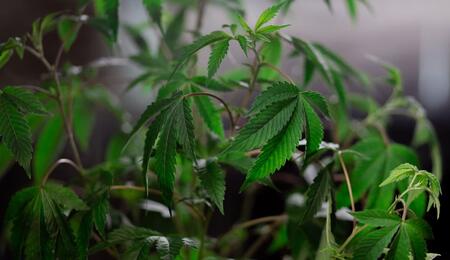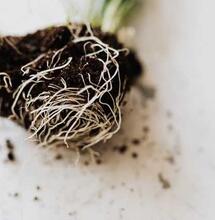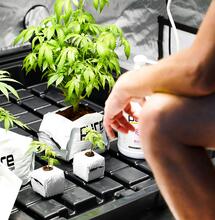The Marvels Of Silicon

What does the word Silicon make you think of? Computer chips or, more likely, porn star tits! How about a beneficial supplement for your plants; one that will make them bigger, stronger, more resilient to pests and disease and capable of yielding more bud? There's more to this element than you may have thought.....
What Is Silicon?
Here’s the science bit, pay attention! Silicon is the second most common element in the earth’s crust – only oxygen is found in a greater abundance – it is found as sand (silicate dioxide) and more commonly as sheet silicates. These are compounds containing silicon, oxygen and an additional metal or mineral and there are literally hundreds of different variations of them forming over 90% of the earth’s crust.
Silicon extracts itself from these sheet silicates in the form of monosilicic acid; this is how it is made available to plants. Soil water – run off from naturally occurring soils – can contain around 400 ppm of silicic acid, which is absorbed by plants. Studies of tissues taken from plants grown in naturally occurring soil show a Silicon content of up to 10% of dry weight. In some cases, Silicon can be found at the same % as calcium, magnesium and phosphorus. Certain grasses can even contain Silicon at a higher % than any other mineral.
It is widely regarded and agreed that plants require 17 key elements to successfully develop. These are comprised of macronutrients; nitrogen, phosphorous, potassium, calcium, magnesium and sulphur, and micronutrients; iron, manganese, boron, copper, molybdenum, zinc, chlorine and nickel. Plus, the obvious elements of carbon, hydrogen and oxygen.
However with Silicon being found in such abundance in plant tissues, there is now an argument that it should be considered as a relevant macronutrient.
Growing Without Silicon
First of all, let’s avoid confusion and get one thing straight; it is widely accepted amongst the wider growing community (by that I mean, our community and that of commercial horticulture) that Silicon is not deemed an essential element for healthy plant development. As stated earlier, it is not one of the 17 key elements that are required for healthy growth and bloom.
However, when plants are grown without Silicon, they run the risk of being structurally weaker than plants grown with. They may be more open to attack from fungal pathogens and pests and can also be more vulnerable to any toxic metals that build up in the root zone.
If you have ever grown hydroponically and thought that your plants seemed a little weaker or more susceptible than previous crops grown in soil, it may be due to a lack of Silicon.
Hydroponic feeds do not contain Silicon in any viable quantity, if at all. The reason for this is that for Silicon to stay soluble, it requires a high pH – greater than 7. Therefore it cannot be included in a normal, hydroponic two-part feed as it would react with the other elements present and this would be very likely to lead to a nutrient deficiency.
For Silicon to be used as a viable additive for your plants, it needs to be kept separate from the basic feed. You could even think of it as your third part to go alongside your usual two-part feed.
How Does A Plant Use Silicon?
Plants can only absorb Silicon in the form of monosilicic acids, these occur naturally as mineral Silicon(silicate sheets) are broken down and dissolved into water. In hydroponic applications, the most common form of Silicon additive is Potassium Silicate.
Once absorbed, Silicon is transported to where it is required by the plants transpiration system, it is deposited as either hydrated silicon dioxide (which effectively stores water molecules within the plant) between the plant cells or as silica (a gel like substance) within the walls of the individual plant cells.
Silicon effectively ‘builds’ the plant, acting as the cement between the bricks in the cell walls or between the actual cells themselves. It increases the structural integrity of the plant, making stems and branches thicker and stronger, and leaves greener and tougher.
The Benefits Of Silicon
The addition of Silicon to your feeding schedule can have an incredible effect on the growth, yield and overall health of your beloved ladies! But, how does it actually benefit your plants? Let’s break it down into bite-sized chunks….
Improved Plant Cell Development – once your plant uptakes Silicon, it is permanently deposited into the cell walls within 24 hours. These deposits form a silica-cellulose framework that are stronger and can be created quicker than they could have been without the inclusion of Silicon. Overall the plant can develop faster and grow quicker when it uptakes Silicon.
Put simply, plant cell walls are like brick walls in a house. When Silicon is taken in by the plant, it is used like cement in a brick wall. So the walls are built quicker and stronger.
Once the ‘cement’ is in place, it cannot be transported elsewhere within the plant, so it’s important to continue to add Silicon throughout the entire growth cycle. This will ensure that all new growth in the plant benefits from the effects.
Balancing Uptake Of Elements – the presence of Silicon in a nutrient solution can positively affect the uptake and absorption of several macro and micro nutrients. Silicon increases Zinc uptake; an essential element in growth and photosynthesis.
Silicon increases the availability of Nitrogen to the plant as its application (in soil) will reduce the loss of Nitrogen to Ammonia (a naturally occurring process in soil). Nitrogen is key in the vegetative stage of plant development as it promotes healthy new foliage growth.
Silicon also balances the uptake of Phosphorus, reducing the risk of toxic levels being taken in by the plant. This is a particularly helpful characteristic to all you home growers that like to use a concentrated bloom stimulator (or root stimulator, for that matter!) with a high PK value.
Protection Against Metal Toxicity – Silicon is known to compete for uptake against certain metal elements that are made available to the plant. These metals include; Aluminium, Manganese and Iron, all essential for plant growth, but an excess of availability of any of the three elements can be problematic for your plants.
If there is a Silicon deficiency around the roots, then plants can uptake these metal elements to toxic levels. This can lead to problems that are not only detrimental to yield, but are also quite difficult to diagnose. So, you could go all the way through your grow, without rectifying the problem and be seriously down on yield at harvest time.
By increasing the dose of Silicon available to your plants, there will be a corresponding increase in the deposits of silica in the cell walls and Silicon will compete against the metals available in the nutrient solution, preventing toxic build ups. Therefore adding Silicon to your feeding schedule protects against metal toxicity.
Maintain Cell Integrity and Plant Strength – this is one of the more obvious effects of adding Silicon. Your plants will be visibly stronger, with wider, thicker stems and branches. The wider the stem, the more uptake and transpiration of water and nutritional elements is possible. So, in theory the plants will grow bigger and at a faster pace.
Also, from a practical point of view, the thicker branches will be able to hold more weight without the need of additional supports. How many times have you got to the fourth or fifth week of flowering and realised that you haven’t put enough support in place to keep your buds stable? This will be less of a problem when using Silicon.
Protection Against Pests and Disease – this is a really fantastic benefit, particularly for home growers who prefer not to spray their plants with pesticides or fungicides. The protection that Silicon offers against fungal pathogens is two-fold:
1. The Silicon that has been deposited in the cell walls effectively toughens the outer ‘skin’ of the plant. This makes it far more difficult for pathogens to penetrate the plant in the first place.
2. If a plant is attacked by a pathogen, for example powdery mildew or pythium, the plant will transport and deposit any Silicon that it uptakes to the area of attack. This then stimulates the production of anti-fungal compounds that halt the infection process.
The toughened outer ‘skin’ reduces the risk of infestation from sucking insects.
Overall Increase In Weight And Bulk – Plants grown with Silicon will have leaves that are darker green, increasing their potential for photosynthesis and better growth. This, together with wider, stronger branches and stems and resilience to disease and pests will ultimately lead to bigger yields.
How To Apply Silicon To Yours Plants
Like most feeds and supplements, Silicon can be administered to your plants in two ways;
1. Mixed with your regular nutrient feed and administered to the roots. This is relevant to the soluble silicate additives.
2. Sprayed onto your plant as a foliar feed.
Within the UK hydroponics industry, there are a number of Silicon supplements and additives available. Most good and knowledgeable grow shops, should be able to point you in the right direction if you are after a Silicon product. Keep an eye out for the following products, as they are readily available throughout the UK;
· Liquid Silicon – made by Growth Technology and probably the most well-known and widely available Silicon additive in the UK. Commonly used a pH Up with added benefits
· Budlink – an Australian soluble silica additive, that can be added to hydroponic nutrient solutions
· Rhino Skin – a potassium silicate additive from the Canadian company, Advanced Nutrients. Soluble enough to be used in a hydroponic nutrient application
· Plant Magic Bio Silicon – a 100% organic Silicon additive, from a UK based company. Suitable for organic growers. Too thick to add to a hydroponic nutrient solution, however can be used as a foliar if you’re growing hydroponically
· DiaHydro – not an additive, but an actual growing medium. Made from fossilised shells of algae (Diatoms) it consists of up to 94% silica, which is released throughout the full growth cycle. No need to add a Silicon supplement with this medium
Now that you’re aware of the powers of Silicon, don’t ignore its value. Regardless of your growing technique; you will benefit from using a Silicon compound as an additive. As a soil grower, you may be introducing Silicon to your plants in the form of silicates found within your soil mix anyway, but by feeding an additional Silicon compound either directly into the soil as a drench, or as a foliar spray, you’ll give your plants extra protection against fungal infection and pest attack. Not to mention thicker, stronger stems and branches.
Hydroponic growers, using a straight A+B feed plus root and bloom stimulators, are unlikely to be feeding their plants any Silicon whatsoever, as regular hydroponic feeds do not contain it. This lowers protection against fungal and pest problems, as well as your plants being potentially weaker and less stable than a plant that has been provided with Silicon. If you’re concerned about adding a soluble Silicon compound to your nutrient solution - blocking drippers and delivery systems, and increasing the pH of your solution - simply feed it as a foliar spray.
Remember, Silicon is the cement that that sits between the bricks in the cell walls of your plants. Once it has been deposited it will not move around inside the plant, so it’s important to continuously feed Silicon throughout the entire life cycle. This will ensure that all new growth in your plants benefits from the effects.
Happy Growing!
.png)


